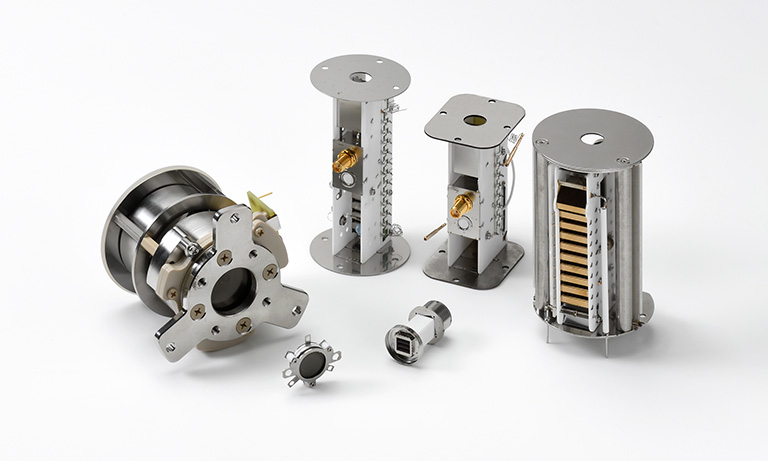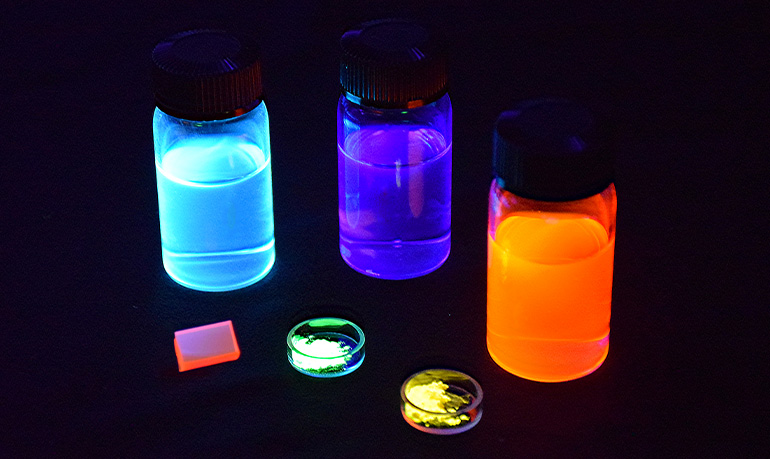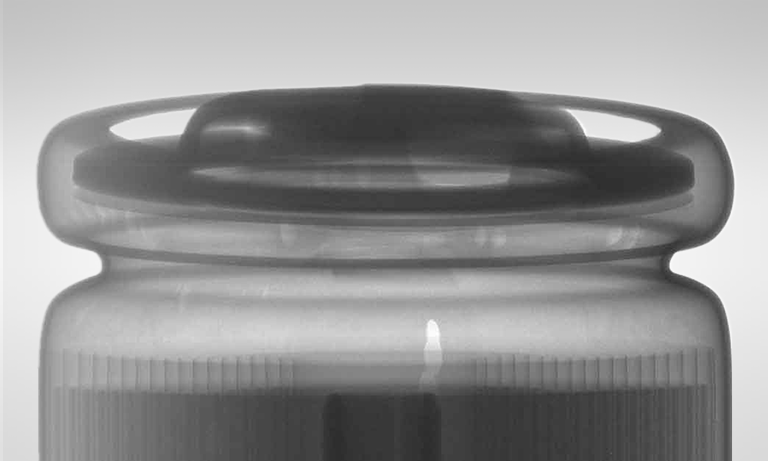United Kingdom (EN)
Select your region or country.
OPD / OLED
"Flexible" photoelectric device
Technical overview
Photoelectric devices using an organic semiconductor attract much attention because of their unique features such as thinness, lightness, and flexibility. In general, semiconductor devices consist of inorganic materials typified by silicon. On the one hand, fabricating “flexible” devices with inorganic materials is essentially difficult owing to their rigidity. On the other hand, organic semiconductors can work in a thin film of 100 nm and be formed on flexible substrates such as plastic or ultra-thin glass films by using ordinary processing techniques such as printing or evaporation. We have investigated an organic photodiode (OPD) as a photosensor and an organic light-emitting diode (OLED) as a light source for an organic photoelectric device.

Fig.1 Organic photoelectric device
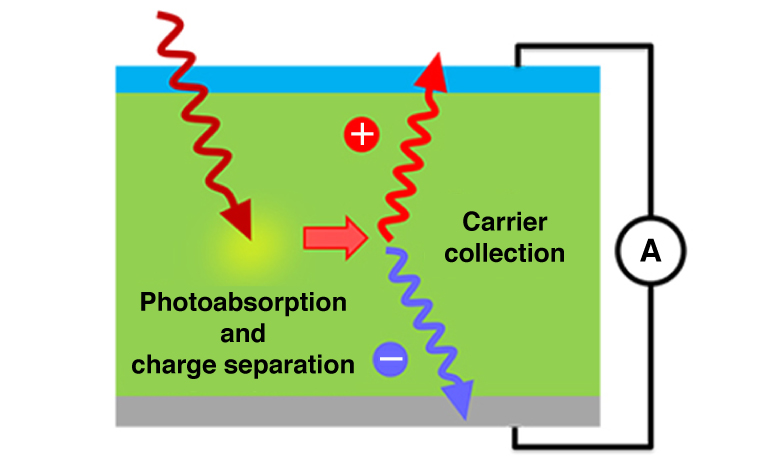
Fig. 2 Working mechanism of OPD and OLED
The basic structure and operating mechanism of the organic photoelectric device is as follows. Both OPDs and OLEDs have a simple structure where the organic semiconductor is sandwiched between an anode and a cathode. In OPDs, the organic layer includes an electron donor molecule and acceptor molecule. When these molecules absorb photons, electrostatically coupled electron-hole pairs called excitons are generated. The excitons diffuse into the donor-acceptor interface and dissociate into the free carrier. Finally, the hole and electron are collected at each electrode and are detected as an electrical signal. Since organic semiconductors have intrinsically similar properties to insulators, the organic layer needs to be extremely thin. This structure suggests that OPDs have conductivity along the vertical (thickness) direction while having high resistance along the horizontal axis. This in turn suggests that electrical crosstalk is barely observed compared to conventional inorganic devices. Moreover, organic semiconductors show a high photoelectric conversion efficiency in thin films because of a high optical absorption coefficient. This characteristic also supports the suitability of organic materials for use as thin devices.
In OLEDs, on the other hand, the hole and electron injected from each electrode recombine in a luminescent organic molecule, and photoemission is observed. OLEDs are suitable for surface emitting light sources in large areas by aid of a sandwiched structure using a transparent electrode and a simple fabrication process. This can achieve high illumination uniformity and a preferred pattern design.
Application
We have developed a flexible OPD with photosensitivity in the near-infrared (NIR) region. The wavelength region around 800 nm is called the “biological optical window” because biological components such as water or hemoglobin (Hb) have less of an absorbance in the NIR region. Thus, light scattering is more dominating rather than absorption, and we can obtain a variety of information about living bodies. We aim to apply the flexible OPD to bio-sensing devices to reduce stress in measurements.
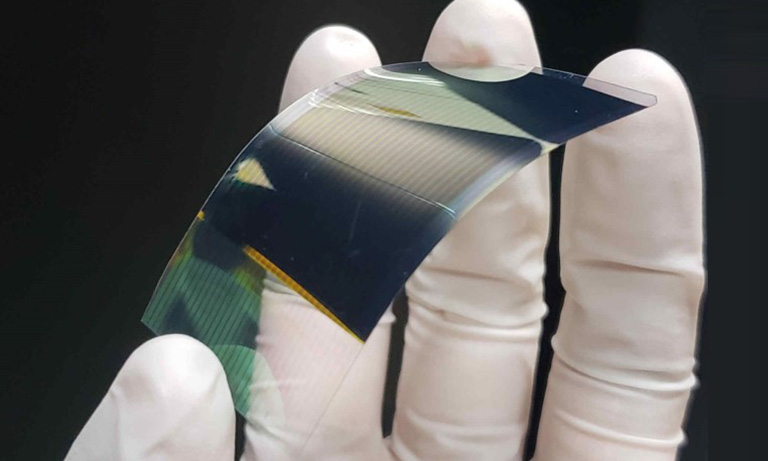
Fig. 3 (a) Flexible OPD
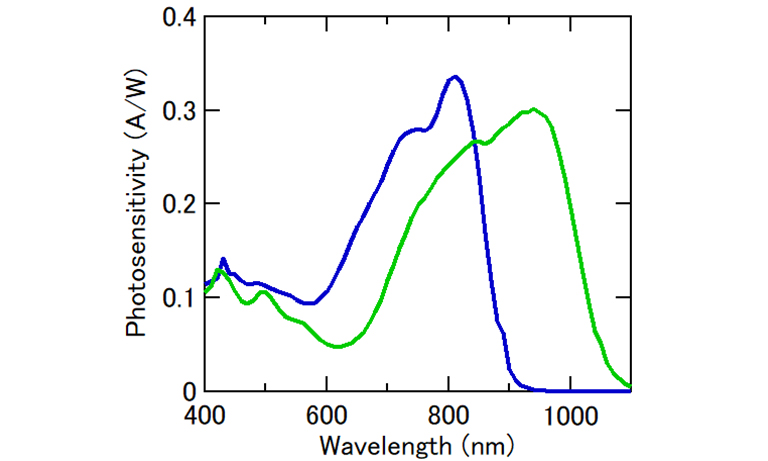
Fig. 3 (b) Spectral response
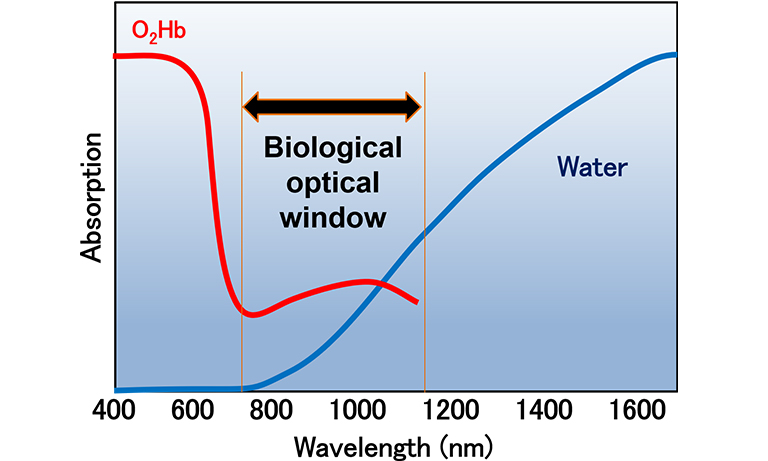
Fig. 4 Biological optical window
We have also demonstrated a large-area NIR-OLED with an arbitrary emitting pattern. Our NIR-OLEDs have an extremely high operational stability even under operation at high current density,* in addition to a radiant power of 1 mW. By taking advantage of the surface emitting device, we can provide a promising light source that irradiates the target uniformly for sensing or for darkfield observation.
■NIR image of our OLED
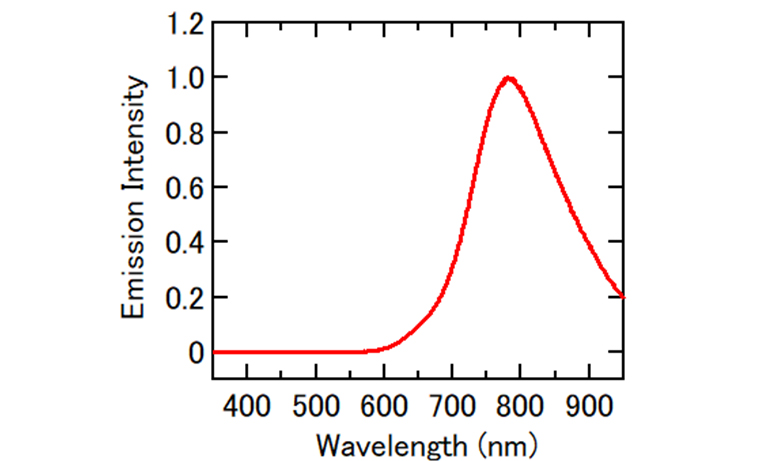
Fig. 5 Emission spectrum

Fig. 6 (a) Conventional LED
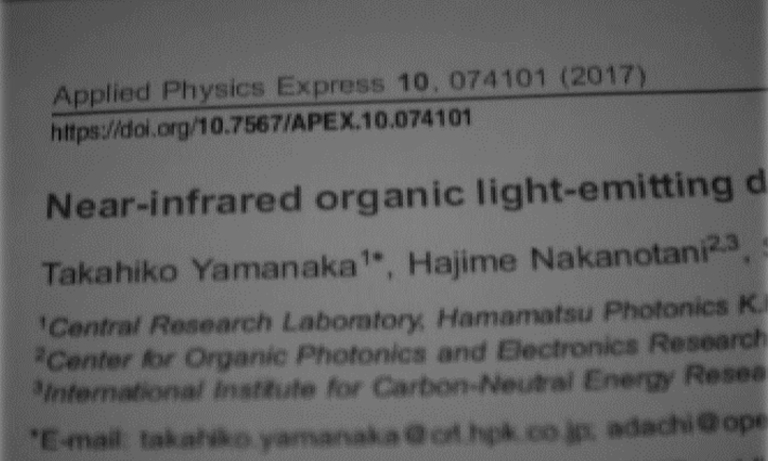
Fig. 6 (b) Surface emitting OLED
Further Potential of Organic Semiconductor
We also focus on the unique optical properties of the organic semiconductor. For example, in some organic emitters studied in the field of OLEDs, charge carriers are generated in a solid-state film by photo-irradiation. In other words, an organic molecule designed as an emitter for OLEDs contains the characteristic of a light-receiving material (References 2-4). The charge carriers generated in the film are stored stably for a long time due to the internal electrostatic potential induced by polarization of the organic molecule and can be extracted again as electroluminescence (charge recombination) by applying an external field. Furthermore, the location and the amount of the charge carrier are simultaneously retained, thus enabling a unique charge storage device with three advantageous features—light-receiving, charge storage, and emission—in a single organic molecule. Figure 7 shows an example of the charge storage ability by irradiating patterned light into the device. The charge carriers are generated only at the exposed area, so the input image can be reproduced as electroluminescence simply by applying the external voltage even after the arbitrary hold time has passed. Notably, the spatial information of the photo-generated carriers is retained even though the device does not have a pixelized structure.
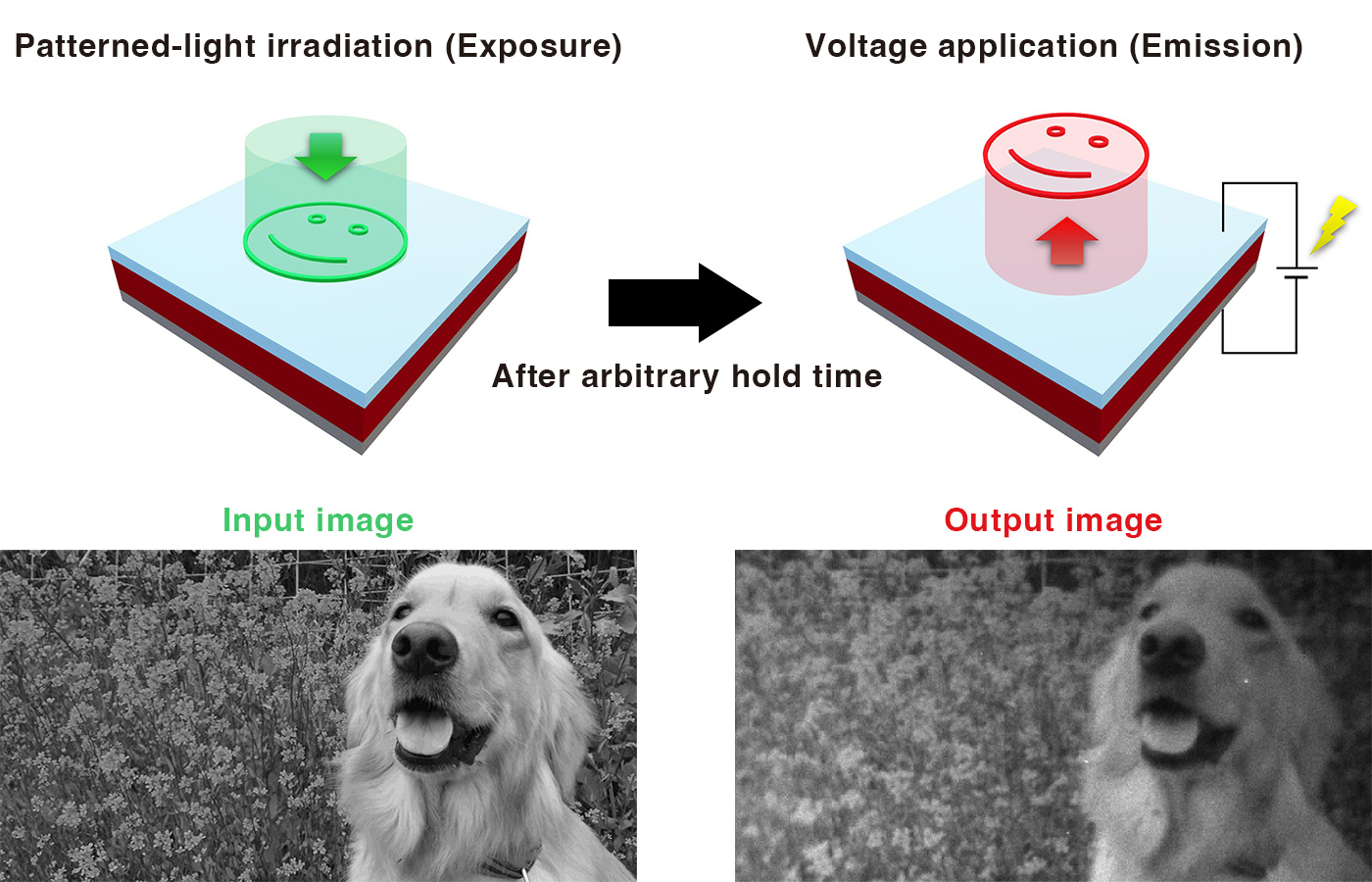
Figure 7. Demonstration of charge storage device
References
1. T. Yamanaka, H. Nakanotani, S. Hara, T. Hirohata, C. Adachi, Near-infrared organic light-emitting diodes for biosensing with high operating stability, Appl. Phys. Express 10, 074101 (2017).
2. T. Yamanaka, H. Nakanotani and C. Adachi, Slow recombination of spontaneously dissociated organic fluorophore excitons. Nat. Commun. 10, 5748 (2019).
3. T. Yamanaka, H. Nakanotani and C. Adachi, Significant role of spin-triplet state for exciton dissociation in organic solids. Sci. Adv. 8, eabj9188 (2022).
4. T. Yamanaka, H. Nakanotani, K. Nakamoto and C. Adachi, Electron lifetime of over one month in disordered organic solid-state films. Adv. Mater. 35, 2210335 (2023).
- Confirmation
-
It looks like you're in the . If this is not your location, please select the correct region or country below.
You're headed to Hamamatsu Photonics website for GB (English). If you want to view an other country's site, the optimized information will be provided by selecting options below.
In order to use this website comfortably, we use cookies. For cookie details please see our cookie policy.
- Cookie Policy
-
This website or its third-party tools use cookies, which are necessary to its functioning and required to achieve the purposes illustrated in this cookie policy. By closing the cookie warning banner, scrolling the page, clicking a link or continuing to browse otherwise, you agree to the use of cookies.
Hamamatsu uses cookies in order to enhance your experience on our website and ensure that our website functions.
You can visit this page at any time to learn more about cookies, get the most up to date information on how we use cookies and manage your cookie settings. We will not use cookies for any purpose other than the ones stated, but please note that we reserve the right to update our cookies.
1. What are cookies?
For modern websites to work according to visitor’s expectations, they need to collect certain basic information about visitors. To do this, a site will create small text files which are placed on visitor’s devices (computer or mobile) - these files are known as cookies when you access a website. Cookies are used in order to make websites function and work efficiently. Cookies are uniquely assigned to each visitor and can only be read by a web server in the domain that issued the cookie to the visitor. Cookies cannot be used to run programs or deliver viruses to a visitor’s device.
Cookies do various jobs which make the visitor’s experience of the internet much smoother and more interactive. For instance, cookies are used to remember the visitor’s preferences on sites they visit often, to remember language preference and to help navigate between pages more efficiently. Much, though not all, of the data collected is anonymous, though some of it is designed to detect browsing patterns and approximate geographical location to improve the visitor experience.
Certain type of cookies may require the data subject’s consent before storing them on the computer.
2. What are the different types of cookies?
This website uses two types of cookies:
- First party cookies. For our website, the first party cookies are controlled and maintained by Hamamatsu. No other parties have access to these cookies.
- Third party cookies. These cookies are implemented by organizations outside Hamamatsu. We do not have access to the data in these cookies, but we use these cookies to improve the overall website experience.
3. How do we use cookies?
This website uses cookies for following purposes:
- Certain cookies are necessary for our website to function. These are strictly necessary cookies and are required to enable website access, support navigation or provide relevant content. These cookies direct you to the correct region or country, and support security and ecommerce. Strictly necessary cookies also enforce your privacy preferences. Without these strictly necessary cookies, much of our website will not function.
- Analytics cookies are used to track website usage. This data enables us to improve our website usability, performance and website administration. In our analytics cookies, we do not store any personal identifying information.
- Functionality cookies. These are used to recognize you when you return to our website. This enables us to personalize our content for you, greet you by name and remember your preferences (for example, your choice of language or region).
- These cookies record your visit to our website, the pages you have visited and the links you have followed. We will use this information to make our website and the advertising displayed on it more relevant to your interests. We may also share this information with third parties for this purpose.
Cookies help us help you. Through the use of cookies, we learn what is important to our visitors and we develop and enhance website content and functionality to support your experience. Much of our website can be accessed if cookies are disabled, however certain website functions may not work. And, we believe your current and future visits will be enhanced if cookies are enabled.
4. Which cookies do we use?
There are two ways to manage cookie preferences.
- You can set your cookie preferences on your device or in your browser.
- You can set your cookie preferences at the website level.
If you don’t want to receive cookies, you can modify your browser so that it notifies you when cookies are sent to it or you can refuse cookies altogether. You can also delete cookies that have already been set.
If you wish to restrict or block web browser cookies which are set on your device then you can do this through your browser settings; the Help function within your browser should tell you how. Alternatively, you may wish to visit www.aboutcookies.org, which contains comprehensive information on how to do this on a wide variety of desktop browsers.
5. What are Internet tags and how do we use them with cookies?
Occasionally, we may use internet tags (also known as action tags, single-pixel GIFs, clear GIFs, invisible GIFs and 1-by-1 GIFs) at this site and may deploy these tags/cookies through a third-party advertising partner or a web analytical service partner which may be located and store the respective information (including your IP-address) in a foreign country. These tags/cookies are placed on both online advertisements that bring users to this site and on different pages of this site. We use this technology to measure the visitors' responses to our sites and the effectiveness of our advertising campaigns (including how many times a page is opened and which information is consulted) as well as to evaluate your use of this website. The third-party partner or the web analytical service partner may be able to collect data about visitors to our and other sites because of these internet tags/cookies, may compose reports regarding the website’s activity for us and may provide further services which are related to the use of the website and the internet. They may provide such information to other parties if there is a legal requirement that they do so, or if they hire the other parties to process information on their behalf.
If you would like more information about web tags and cookies associated with on-line advertising or to opt-out of third-party collection of this information, please visit the Network Advertising Initiative website http://www.networkadvertising.org.
6. Analytics and Advertisement Cookies
We use third-party cookies (such as Google Analytics) to track visitors on our website, to get reports about how visitors use the website and to inform, optimize and serve ads based on someone's past visits to our website.
You may opt-out of Google Analytics cookies by the websites provided by Google:
https://tools.google.com/dlpage/gaoptout?hl=en
As provided in this Privacy Policy (Article 5), you can learn more about opt-out cookies by the website provided by Network Advertising Initiative:
http://www.networkadvertising.org
We inform you that in such case you will not be able to wholly use all functions of our website.
Close











